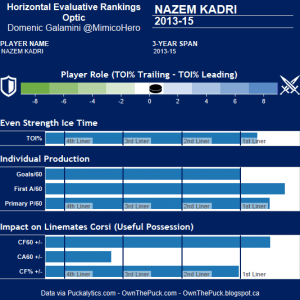Hello and Merry Christmas. I thought I would use this column today to talk about the most misunderstood and polarizing player in Leafs Nation: Nazem Kadri.
Frustratingly, the Leafs best draft-pick since Wendel Clark had the misfortune of timing his breakout year with a terrible streak that saw his great play sandbagged by horrible luck. From the first game of the season to November 29th, Kadri scored on just 1.5% of his own shots, and he and his line-mates combined to score on just 5.4% of their total shots.
This led to people who should know better – i.e people being paid for their opinion – to say the Leafs should refuse to extend his contract, and to rate him lower than Tyler Bozak on the quarter-pole report cards (both absolutely ridiculous).
The fact is, in all analysis, no matter what the topic, the first thing you are supposed to do is judge the process, not the results. This is a basic tenet of science, and in hockey, goals are the result, not the process. The reason for this is that results can vary wildly, so it is better to measure the process in order to get an obstructed view of what is happening.

If we look at Kadri’s possession numbers, his scoring-chances attempts, his scoring-chance differential, and his shot totals, he has numbers comparable to the best players in the NHL.
But fans want results, and that is understandable. It just isn’t fair.
To watch TV and see paid analysts saying things like “Kadri just has to shoot from better spots” is so frustrating because that is objectively wrong. A player cannot control whether the goalie makes a save or plays poorly. Up to November 29th, Kadri was shooting 1.5%. In the NHL, about 8 or 9% of all shots are goals, meaning that Kadri would have to be about 4.5 x worse than average for his percentage to be a reflection of his skill. Anyone who has seen him play knows that can’t be true.
For a 1.5 shooting percentage to be an accurate reflection of his play, it would mean that while Kadri is great at getting shots off, he is literally the worst shooter in the history of the league. We know this can’t be true.
Also, he shoots over 10% for his career, so why is it so hard for people to think that a 22 game sample is less representative than his 280 career games in total? Add in the fact that the shooting percentage of all players on the ice with Kadri was just 5% (compared to at least double for most players in the scoring leaders race) and it’s clear that his one goal and three assists at 5v5 up to November 29th was nothing but bad luck.
Since the Streak Ended
In the ten games since November 29th, Kadri’s personal shooting-percentage is back up to around his career norms, at 10.7 %, and the combined shooting-percentage of his line-mates is back up to around 10% as well.
During this time, he has six points and three goals in ten games at even-strength, which is a 25 goal/50 point pace. Had his coach not removed James Van Riemsdyk from his line (a move that makes the Leafs a much worse team, by the way) these numbers would likely be even higher.
And keep in mind that these are even-strength numbers. Last year, 25 5v5 goals would have been 9th in the NHL and in a tie with Alexander Ovechkin. Fifty 5v5 points would have been good for 11th place overall in the NHL and one point more than Sidney Crosby scored.
I might also be remiss if I didn’t point out that as a positive possession player who is near the top of the league in scoring-chance differential (he’s been on the ice for 94 more scoring chances for than against so far). Kadri has been so effective as a two-way player that he helps his team in games even when he doesn’t score.
So, just to recap, since ending a clearly identifiable, objective and indisputable streak of bad luck, Kadri has scored at a league-leading pace and has, for the entire year so far, been one of the NHL’s most effective two-way centres.
So with apologies to Craig Button and Jeff O’Neil, his game gets an A+ and he fully deserves a contract extension. Because, frankly, Nazem Kadri is an elite #1 NHL centre and a player the Leafs should build around.
